Psych 2101
1/40
There's no tags or description
Looks like no tags are added yet.
Name | Mastery | Learn | Test | Matching | Spaced |
|---|
No study sessions yet.
41 Terms
• What is a mental disorder?
A mental disorder is characterized by a clinically significant disturbance in an individual's cognition, emotional regulation, or behaviour. It is usually associated with distress or impairment in important areas of functioning.
• What is classification?
Classification is “the act or process of dividing things into groups according to their type”(Cambridge dictionary)
Mental disorders, however, are classified by symptoms that meet specific “diagnostic criteria”.
• Why should we classify mental disorders?
Most medical disorders are classified by results of biological testing. • Ex. Diabetes and fasting glucose + glucose tolerance test
Mental disorders are classified by observable behaviours (signs) and self-reported feelings and thoughts (symptoms).
Who is emil kraepelin? (Defined 15 categories of mental disorders based on common patterns of symptoms, Most famous for the “Krapeliniandichotomy”: dementia praecox (schizophrenia) vs manic depression)
Why should mental disorders be classified at all?
It’s debatable, but there are some good reasons:
• Provides a common vocabulary across psychologists, psychiatrists, GPs, social workers, governments, etc.
• Provides a guide for treatment
• Can be used in legal settings → see if they are fit to stand trial or lesser sentencing
Some disadvantages:
• Stigma
• Changes self-concept (e.g., being “abnormal”)
• Insurance problems
• How do we classify mental disorders?
categorical, dimensional, and transdiagnostic approach
The categorical approach
Based on DSM-V or ICD-11 criteria
Diagnostic categories include disorders, subtypes, and changes overtime
There are 22 diagnostic categories in the dsm5
Limitations of the categorical approach
Including a disorder in the DSM or ICD makes people believe that the disorder is real
• A real category, different from others. → isolates people
* Ignores overlap between disorders.
• People classified with the same disorder may have few symptoms in common.
(eg internert gaming disorder)
Example of categories not matching reality → a platypus
The dimensional approach
• Not yes or no (i.e., you’ve got it or you don’t), but how much?
• Each i• Most mental disorders can be described along a number of symptom dimensions individual receives a score on several different ‘dimensions’ of psychopathology. This includes emotional symptoms (fear), cognitive symptoms (fear of losing control/dying/derealisation), and physical symptoms (sweating)
Example
• Hallucinations and delusions are distributed continuously in the population.
• Subclinical psychotic experiences (8%)
• Subclinical psychotic symptoms which are associated with a degree of distress and help-seeking behaviour but do not necessarily amount to clinical psychotic disorder (prevalence
around 4%).
• Psychotic disorder (3%)
what are examples of dimensional approaches?
Beck Depression Inventory is a dimensional approach
Minnesota Multiphasic Personality Inventory (MMPI)
First developed in 1943, updated in 1989, 2008, and 2018
• 10 ‘dimensions’ (clinical scales) of psychopathology along which people differ e.g., hypochondriasis (HS), depression (D), paranoia (PA), psychasthenia (PT), hypomania (MA), psychopathic deviate (PD) etc.
• Individual’s score on each dimension is compared to population norms
Millon Clinical Multiaxial Inventory
>20 dimensions
With loads of dimensions can defeat the purpose of the easy classification mechanism → plus no common communication between each group
Limitations of the Dimensional Approach
• No common vocabulary
• Unwieldly
• Implications for treatment?
• Knowing severity of disorder may not impact treatment plan.
• E.g., what’s the best way to treat someone who is high on hypochondriasis, but low on depression, but high on social introversion, but low on paranoia etc….
• Does a consistent pattern map on to a specific diagnostic category?
The transdiagnostic approach
Very new approach (last 10 years)
National Institute of Mental Health’s (USA) Research Domain Criteria
Launched in 2009
Characteristics of RDoC:
• Holistic approach
• Understanding interaction between brain development, social factors, and lifespan to identify multiple dimensions that may produce mental illness.
• Study of biological processes and behavior that are part of interpersonal and sociocultural milieu
• From genes and cells to human behaviour
Not for immediate clinical use
Will take many years of research before it will influence classification
Domains of RDoc (SAS NPC)
negative valence, positive valence, cognitive systems, systems for social processes, arousal/regulatory systems, sensorimotor systems
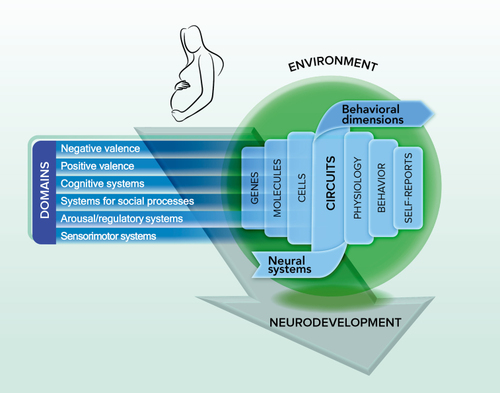
what is RDoC
The RDoC system takes a whole-dimensional approach to analyzing human behavior, encompassing both typical and atypical functioning, and utilizes evidence from biological, behavioral, and self-report studies.
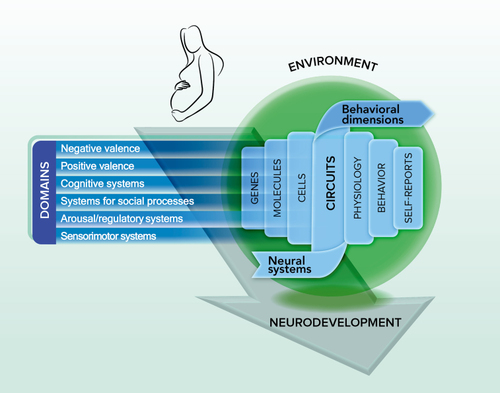
explain the dimensions of RDoC
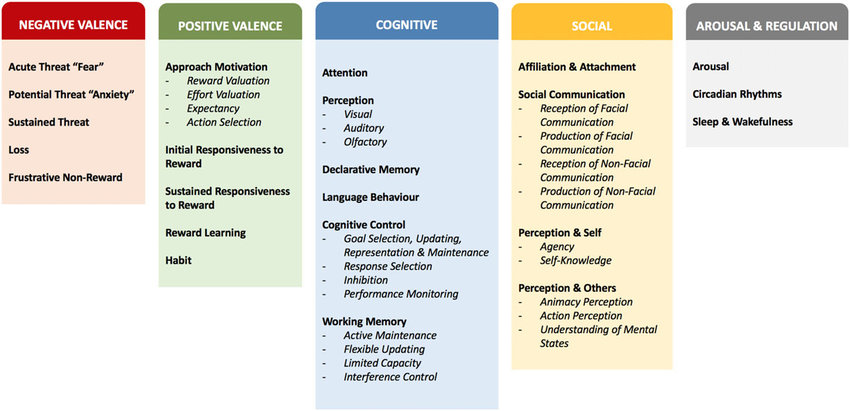
what is HiTOP?
the hierarchical taxonomy of psychopathology
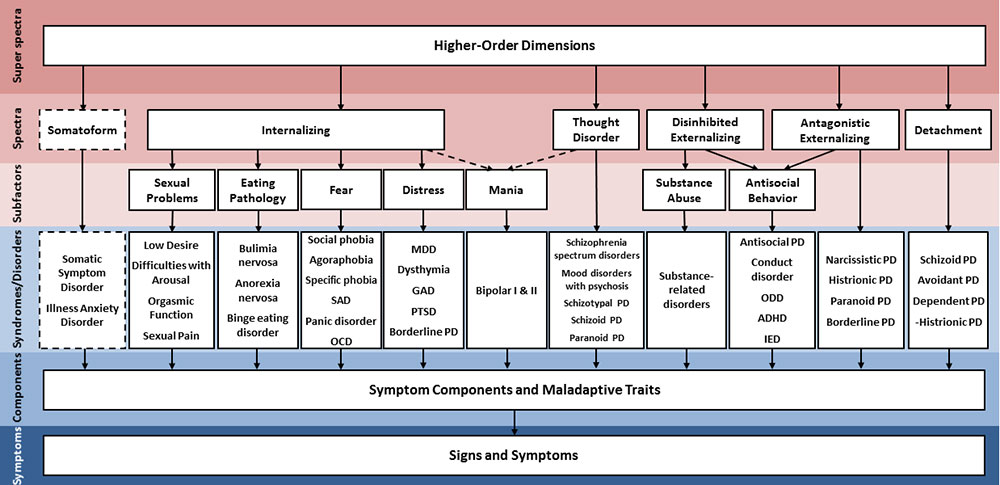
Advantages of Categorical
Common vocabulary, aids in communication
Provides a guide for treatment and prognosis
Advantages of Dimensional
Closer to reality?
Doesn’t require arbitrary distinctions between normality and abnormality
A categorical approach to assessment relies on
diagnostic criteria to determine the presence or absence of disruptive or other abnormal behaviors
a dimensional approach places such behaviors on a
continuum of frequency and/or severity
what is taxometric?
Taxometrics is a statistical procedure for determining whether relationships among observables reflect the existence of a latent taxon (type, species, category, disease entity).
transdiagnostic approach
A mechanistically transdiagnostic approach identifies psychological processes that underlie a given class of disorders (e.g., overvaluation of shape and weight for eating disorders
The transdiagnostic approach seeks to treat that underlying cause directly. In doing so, people can learn coping skills that will be relevant to a variety of mental health problems, improving their overall mental health now and in the future.
what is RDoC
Research Domains Criteria Project (RDoC)
RDoC is a research framework for new approaches to investigating mental disorders. It integrates many levels of information (from genomics and circuits to behavior and self-reports) in order to explore basic dimensions of functioning that span the full range of human behavior from normal to abnormal.
"RDoC is an attempt to create a new kind of taxonomy for mental disorders by bringing the power of modern research approaches in genetics, neuroscience, and behavioral science to the problem of mental illness."
Research domains encompass various fields of study that contribute to the advancement of knowledge and understanding in different areas. They provide specialized frameworks for conducting research and generating insights within specific disciplines.
What are psychometrics?
• The branch of psychology dealing with the design, administration, and interpretation of quantitative tests for the measurement of psychological variables
• Psyche = mind, metric = measure
• Psychometrics involves the measurement of directly unobservable mental constructs (e.g., intelligence, aptitude, personality, etc.) as opposed to directly observable physical constructs (e.g., height, weight, antibody levels, etc.)
What is a mental construct?
• Theoretical, intangible quality or trait.
• A psychological test aims to measure mental constructs (latent construct) by inferring an individual’s true score on the construct from their observed test score.
Aggressiveness
Emotional stability
Depression
Fear of vaccination
Intelligence
Beliefs in conspiracy
• Assumptions underlying psychometrics
1. It is possible to measure psychological states and traits.
2. Various methods of measuring aspects of the same thing can be useful.
3. Assessment can provide answers to some of life’s most momentous questions. Examples:
4. Error is part of the assessment process.
5. Testing and assessment can be conducted in a fair and unbiased manner.
• Measurement error
Two types of measurement error
• Random error: unpredictable influences that vary from measurement to measurement.
• e.g. participant didn’t have their morning coffee or has the flu, examiner didn’t give clear instructions etc.
• Influences go in both directions —sometimes increasing a score and sometimes decreasing it
• Systematic error: biases that influence scores in a similar way across multiple measurements
• e.g., using vocabulary as a measure of IQ in ESL participants
• Influences generally go in one direction —consistently increasing or decreasing a score
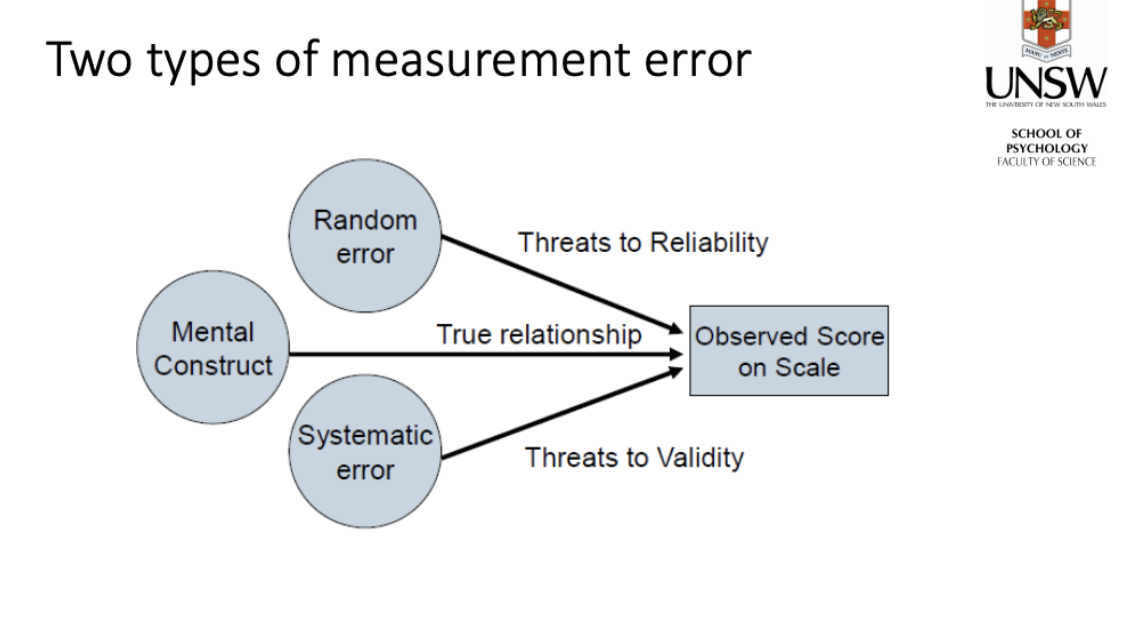
Reliability:
Consistency of measurement
Validity:
Accuracy of measurement
Types of Reliability
• Temporal stability
• Are the results of an assessment instrument stable over time?
• Test-retest reliability
• Inter-rater reliability
• Can raters agree on the scores of an instrument?
Can the two people collecting data get the same scores?
• Inter-rater reliability
• Internal consistency reliability
• Are there positive correlations among items that are intended to measure the same construct?
• Cronbach’s alpha (α)
Test-retest Reliability
• Will taking the assessment again yield the same results?
• Administer a test once and then again later.
• Limitations: practice effects, fatigue, expensive
Inter-rater reliability
• Do two different raters yield the same results?
• Often used with subjectively-scored measures like coding written responses.
• Test is scored by two or more raters. Sets of scores are correlated with one another.
Internal consistency reliability
• Extent to which test items that propose to measure the same construct actually show similar scores
• Strong correlations between items within a scale
• To increase internal consistency reliability:
• Increase the number of items
• Remove items that are uncorrelated with many of the other items.
brunswicks lens model
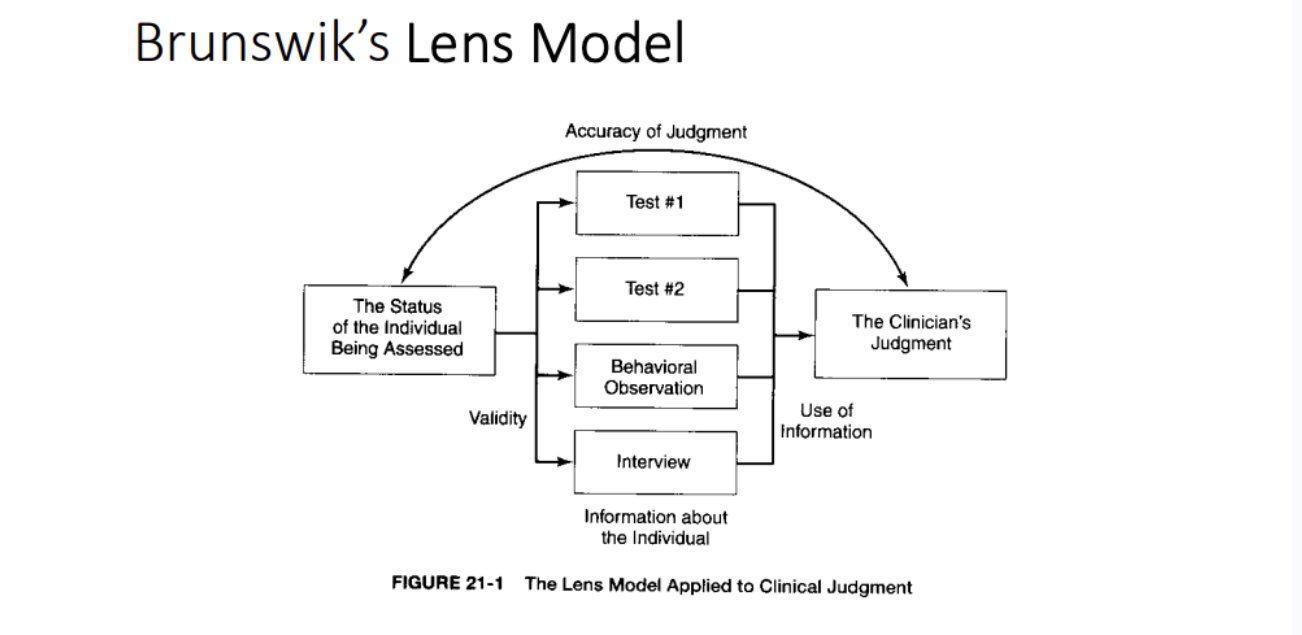
3 major sources of error
• Reliability
• Validity
• Errors in use of method
types of validity
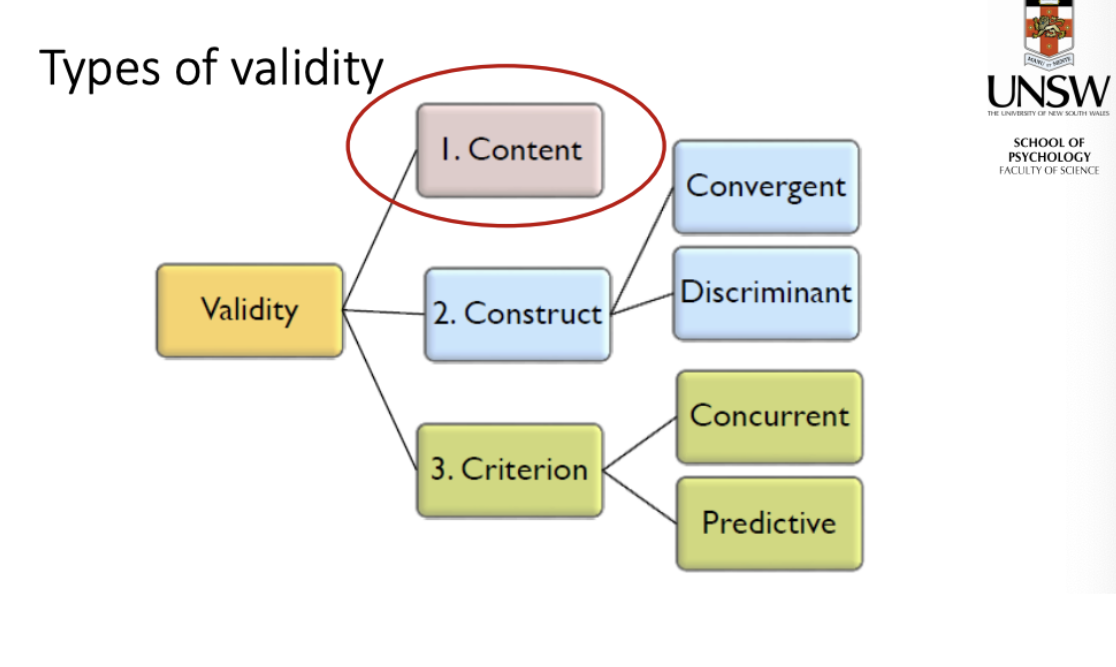
Content validity
• The degree to which the items adequately sample the mental construct in question
• e.g., Imagine 2 measures of general intelligence (IQ)
• Scale A only includes a vocabulary measure
• poor content validity
• Scale B includes measures of vocabulary, arithmetic, working memory, matrix reasoning, mental rotation, etc
• better content validity
• Fictitious example (don’t freak out ☺): 2101 final exam only has 3 questions and they are all on interrater reliability
Construct validity
• A scale is said to have high construct validity if:
1)It correlates with other tests purporting to measure the same construct (and hence they converge on measuring the same construct).
Convergent Validity
2)It does not correlate with other tests that do not purport to measure the same construct (and hence, their scores discriminate between different constructs).
Discriminant Validity → always have discriminant validity
Construct validity - convergent
• Demonstrated when a measure correlates highly with other measures with which it theoretically should correlate.
Criterion validity
• Degree to which the test is able to predict present or future performance on some real-world outcome (i.e., the criterion)
• Concurrent validity:
refers to the degree in which the scores on a measurement are related to other scores on other measurements that have already been established as valid.
.Does test score accurately predict present scores on the criterion?
• i.e., the test and the criterion are assessed at the same time
• e.g. Predicting who has clinically-diagnosed major depression based on their score on the DASS
• Predictive validity:
Does test score accurately predict future scores on the criterion?
• Predicting future convictions for crimes from a measure of self control
To increase internal interrater reliability:
• Train and practice
• To increase test-retest reliability:
• Maintain standardized protocol